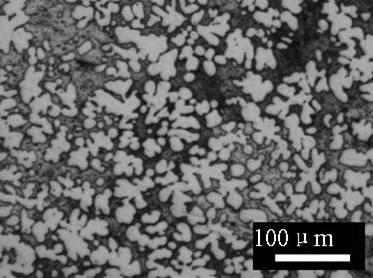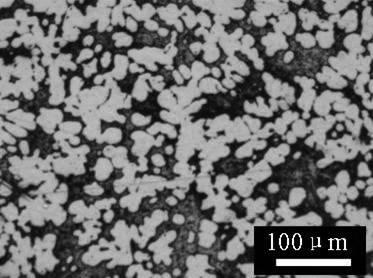Epsilon phase modification agent in zinc-copper alloy and modification method
A technology of copper alloy and modifier, applied in the field of alloy materials, to achieve the effects of convenient operation, reduced grain size, and increased number of crystal nuclei
- Summary
- Abstract
- Description
- Claims
- Application Information
AI Technical Summary
Problems solved by technology
Method used
Image
Examples
Embodiment 1
[0032] The modification treatment method of ε-phase dendrites in the Zn-8Cu alloy (the mass percentage of Cu in the alloy is 8%, and the liquidus temperature is about 530°C), the specific steps are as follows.
[0033] (1) Melt the Zn-8Cu alloy to 590°C to obtain a Zn-8Cu alloy melt.
[0034] (2) Add a certain amount of pure bismuth into the above melt so that the mass percentage of bismuth element in the alloy is 0.5%, and then stir the melt.
[0035] (3) After 8 minutes, stir the alloy melt again to make the bismuth element evenly distributed in the melt. Then the above melt is poured into the mold, and the modified zinc-copper alloy is obtained after cooling.
[0036] In this example, before the Zn-8Cu alloy is modified, the ε phase branches are well developed, and the size of the primary dendrite is more than 200 μm, and the primary dendrite contains a large number of secondary dendrites (the size can reach more than 100 μm) and a small amount of tertiary dendrites ( fig...
Embodiment 2
[0038] The modification treatment method of the epsilon phase dendrite in the Zn-8Cu alloy (the mass percentage of Cu in the alloy is 8%), the specific steps are as follows:
[0039] (1) Melt the Zn-8Cu alloy to 615°C to obtain a Zn-8Cu alloy melt.
[0040] (2) Add a certain amount of pure bismuth into the above melt, so that the mass percentage of bismuth element in the alloy is 0.1%, and stir to make the bismuth element evenly distributed in the melt.
[0041] (3) Then pour the above melt into a mold, and obtain a modified zinc-copper alloy after cooling.
[0042] In this example, before the modification of the Zn-8Cu alloy, the ε phase branches are developed, and the size reaches more than 200 μm. After the modification by the method of this example, the ε phase grain branches are obviously suppressed and reduced, and the size is only about 70 μm ( image 3 ).
Embodiment 3
[0044] The modification treatment method of the epsilon phase dendrite in the Zn-8Cu alloy (the mass percentage of Cu in the alloy is 8%), the specific steps are as follows:
[0045] (1) Melt the Zn-8Cu alloy to 600°C to obtain a Zn-8Cu alloy melt.
[0046] (2) Add a certain amount of pure bismuth into the above melt, so that the mass percentage of bismuth element in the alloy is 1%, and stir to make the bismuth element evenly distributed in the melt.
[0047] (3) Then pour the above melt into a mold, and obtain a modified zinc-copper alloy after cooling.
[0048] In this example, before the Zn-8Cu alloy is modified, the ε phase branches are developed, and the size reaches more than 200 μm. After the modification by the method of this example, the ε phase grain branches are significantly reduced, and the size is only about 90 μm ( Figure 4 ).
PUM
| Property | Measurement | Unit |
|---|---|---|
| size | aaaaa | aaaaa |
| size | aaaaa | aaaaa |
| size | aaaaa | aaaaa |
Abstract
Description
Claims
Application Information
 Login to View More
Login to View More - R&D
- Intellectual Property
- Life Sciences
- Materials
- Tech Scout
- Unparalleled Data Quality
- Higher Quality Content
- 60% Fewer Hallucinations
Browse by: Latest US Patents, China's latest patents, Technical Efficacy Thesaurus, Application Domain, Technology Topic, Popular Technical Reports.
© 2025 PatSnap. All rights reserved.Legal|Privacy policy|Modern Slavery Act Transparency Statement|Sitemap|About US| Contact US: help@patsnap.com



